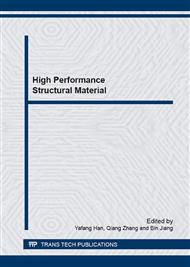p.375
p.381
p.387
p.393
p.399
p.404
p.411
p.418
p.424
Microstructural Evolution and Mechanical Behavior of AZ31 Magnesium Alloy Sheets with Li Addition
Abstract:
AZ31 magnesium alloy and its alloy with 5% lithium were extruded to 1mm in thickness sheets at 380 oC with extrusion ratio of 101. Microstructure evolution and mechanical behavior of the extruded Mg alloy sheets were examined. The microstructure and texture evolution were investigate by electronic backscattered diffraction (EBSD) and X-ray diffraction (XRD). Mechanical performance was carried out by tensile tests at room temperature. In addition, the evolution of neutral layer and microstructure was also examined by V-bending. It was found that Li addition resulted in the strong divergence of the grain orientation. (0002) basal texture of AZ31 alloy sheets with 5% lithium has been weakened. The room temperature ductility of these textural sheets was enhanced owing to the tilted weak basal texture. Moreover, it exhibits superior ductility during V-bending process at room temperature.
Info:
Periodical:
Pages:
399-403
Citation:
Online since:
April 2015
Authors:
Keywords:
Price:
Сopyright:
© 2015 Trans Tech Publications Ltd. All Rights Reserved
Share:
Citation:


